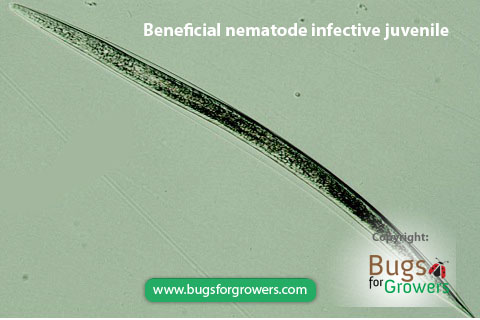Four beneficial nematodes from Portugal
Four beneficial nematodes (Photo 1) including Heterorhabditis bacteriophora, Steinernema feltiae, Steinernema intermedium and Steinernema kraussei have been recently reported from continental Portugal (Valadas et al., 2014). These nematodes were isolated from the soil collected from both agriculture and forest lands. Steinernema feltiae was found to be predominantly distributed in both agricultural and forest areas suggesting that this nematode have a wide range of host insects that may be infesting agricultural crops as well as forest shrubs and trees (Valadas et al., 2014). Molecular analysis of COXI and cytb genes showed no genetic diversity among the isolates of Heterhabditis bacteriophora nematodes (Valadas et al., 2014). Of these four species of beneficial entomopathogenic nematodes, Heterorhabditis bacteriophora, Steinernema feltiae, and Steinernema krausseiare are commercially produced for both US and European markets. These three nematode species are currently used as excellent biological agents to control soil-dwelling stages of many insect pests that cause a serious damage to many agricultural, greenhouse, horticultural, ornamental and nursery crops.
What are Heterorhabditis bacteriophora nematodes?
Beneficial Heterorhabditis bacteriophora are warm adapted nematodes meaning that they are very effective in killing their insect hosts in the field when temperatures are between 20°C and 29°C. This nematode uses a “cruise” foraging strategy to search less mobile stages of insect hosts like white grubs and black vine weevils by moving actively throughout the soil profile. Beneficial Heterorhabditis bacteriophora nematodes are known to infect and kill soil-dwelling stages of a wide range of insect pests including Annual bluegrass weevil (Listronotus maculicollis), Banana moth (Opogona sachari), Billbug (Sphenophorus spp.), Black vine weevil (Otiorhynchus sulcatus), Borers (Synanthedon spp.), Citrus root weevil (Pachnaeus spp.), Corn rootworm (Diabrotica spp.), Diaprepes root weevil (Diaprepes abbreviates), Fungus gnats (Bradysia spp.), Grape root borer (Vitacea polistiformis), Iris borer (Macronoctua onusta), Oriental beetle (Anomala orientalis), Sugar beet weevil (Temnorhinus mendicus), Sweet potato weevil (Cylas formicarius), Western corn rootworm (Diabrotica virgifera virgifera), Western flower thrips (Frankliniella occidentalis) and White grub (Popillia japonica). Infective juveniles of Heterorhabditis bacteriophora always carry symbiotic bacteria called Photorhabdus luminescensin their gut as weapon to kill their insect hosts. These infective juveniles enter into the body cavity of their insect hosts via natural opening like mouth, anus, spiracles and/or through the cuticle. After entering into insect body cavity, infective juveniles release bacteria via anus in the blood. Released symbiotic bacteria then multiply rapidly and cause septicemia that kills their insect hosts usually within 24 - 48 hours after infection. In the insect cadaver, nematodes feed on multiplying bacteria as food develop, reproduce and complete 2-3 generations. After depletion of food (when bacteria stop multiplying), nematodes exit cadavers as infective juveniles to seek new hosts and the life cycle continues.
What are Steinernema feltiae nematodes?
Beneficial Steinernema feltiae nematodes are cold tolerant nematodes meaning these nematode can infect and kill insects as low as 10°C (50 °F) temperature and as high as 25°C (77 °F) temperature. Steinernema feltiae nematode uses an intermediate foraging strategy that is between the ambush (wait-and-sit strategy) and cruiser type. This nematode is very effective against mushroom flies and fungus gnats in mushroom houses and greenhouses, respectively. Beneficial Steinernema feltiae can also infect and kill soil-dwelling stages of a wide range of insect pests including Beet armyworm (Spodoptera exigua), Codling moth (Cydia pomonella), Colorado potato beetle (Leptinotarsa decemlineata), Corn earworm (Helicoverpa zea), Fall armyworm (Spodoptera frugiperda), Fungus gnat (Bradysia difformis), Imported cabbageworm (Pieris rapae), Leafminers (Liriomyza spp.), Shore flies (Scatella spp.), Sweetpotato weevil (Cylas formicarius), Sweetpotato whitefly (Bemisia tabaci) and Western flower thrips (Frankliniella occidentalis). Beneficial Steinernema feltiae nematode infective juveniles also carry species-specific symbiotic bacteria called Xenorhabdus bovienii in their gut as weapon to kill their insect hosts. Like other species of beneficial entomopathogenic nematodes, Steinernema feltiae nematodes also enter their insect host’s body cavity through the natural openings such as mouth, anus and spiracles. Once in the cavity, infective juveniles release Xenorhabdus bovieniibacteria via anus in insect blood. Released bacteria then multiply rapidly and cause septicemia that kills insect hosts within 48 hours of infection. In the insect cadaver, nematodes feed on multiplying bacteria, develop and reproduce. Then after completing 2-3 generations and sencing the depletion of food (that is when bacteria stop multiplying), nematodes exit cadavers as infective juveniles to seek new hosts and the life cycle continues.
What are Steinernema kraussei nematodes?
Beneficial entomopathogenic Steinernema kraussei nematodes are cold tolerant nematodes meaning these nematode can infect and kill insects as low as 3-5°C (37.4-41 °F) temperature. This nematode is famous for its effectiveness specfically against black vine weevil, Otiorhyncus sulcatus, which is one of the major pests of many ornamental plants. Larvae of black vine weevil generally feed on plant roots whereas adult weevils feed on the edges of leaves and flowers. Like other entomopathogenic nematodes, infective juveniles of beneficial Steinernema kraussei nematodes always carry symbiotic bacteria called Xenorhabdus sp. in their gut as weapon to kill their insect hosts. Beneficial Steinernema kraussei nematodes also enter their insect host’s body cavity through the natural openings such as mouth, anus and spiracles. Once in the cavity, infective juveniles release Xenorhabdus bacteria via anus in insect blood. Released bacteria then multiply rapidly and cause septicemia that kills insect hosts within 48 hours of infection. In the insect cadaver, nematodes feed on multiplying bacteria, develop and reproduce and complete 2-3 generations. After sensing depletion of food inside the cadavers (when bacteria stop multiplying), nematodes exit cadavers in the soil as infective juveniles to seek new hosts and the life cycle continues.
Please read my blog post entiled "Twelve important facts about beneficial entomopathohenic nematodes" about more information on beneficial entomopthogenic nematodes.
